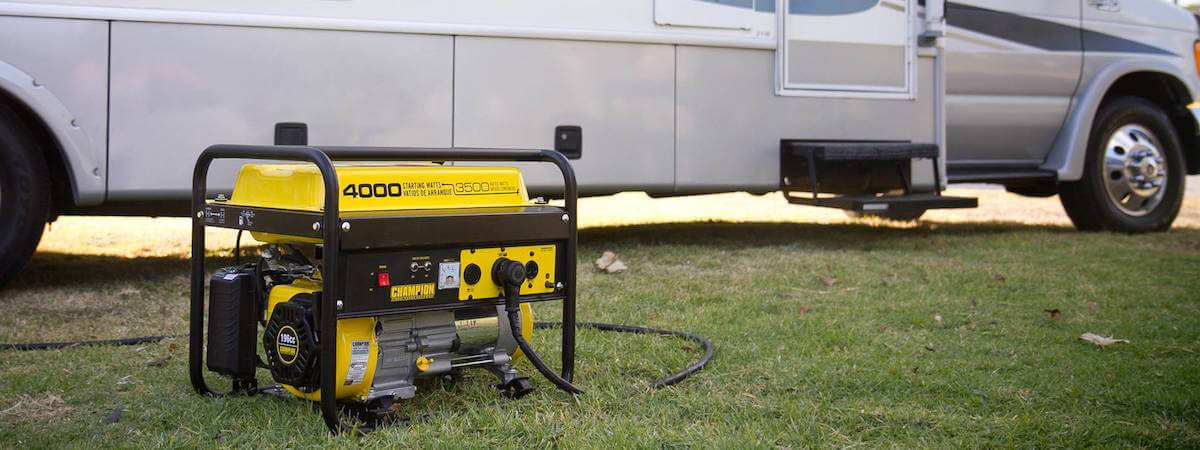
When you go camping or boondocking, the best RV generator is a top item on your packing list. Whatever the circumstances, it’ll let you have lights, a working water pump, and an air conditioner. It’ll power up your RV outlets and save your smartphone battery from going flat so that you can call for help once you need it.
The generators for RV vehicles differ greatly depending on the task (heavy / light duty) and other factors. Looking for a power station for your RV, check the following parameters:
- Wattage. Depending on the number of appliances used in your RV, you might need a more or less powerful generator. The specs of the devices should also be considered. The generator might be enough to power 400W TV and several 100W lamps but be insufficient to start the 3,500W air conditioner (15,000 BTU often used in RVs).
- Fuel. Gas, gasoline, diesel, or propane — each type of generators can be efficient for a particular task, while the fuel consumption and noise level differ.
- Run time. Small generators running approximately 4 hours on a single tank, fit the light-duty camping purposes, while the 8-10 -hours generators secure your RV better in case of shore supply fail or any emergency.
- Noise level. The quieter the better. Generator noise differs from audible buzzing to roaring.
- Operation. Automatic start is preferable to the manual pulling at the cord, both for safety, efficiency and comfort.
RV Generator Reviews
DuroStar DS4000S
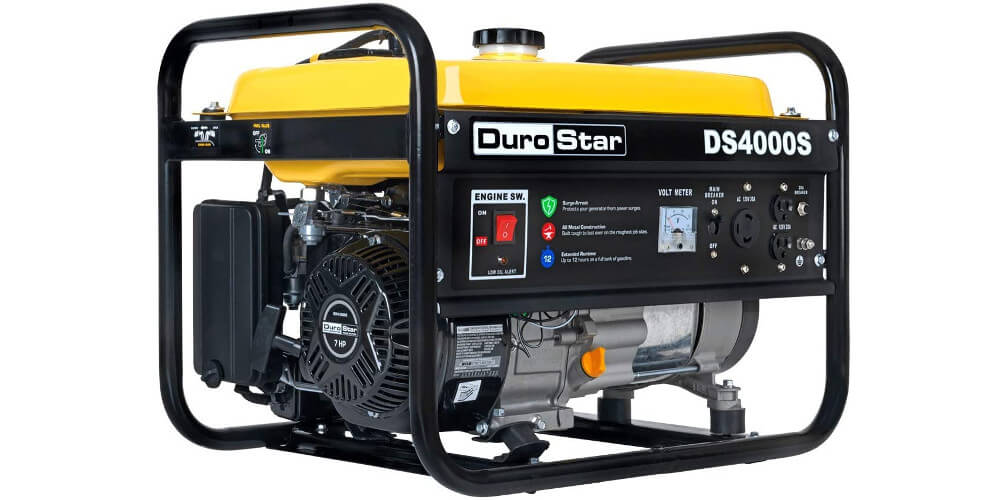
The sturdy build and versatility make this 30-Amp RV generator a worthy option for any kind of camping. It can power various equipment and features smart safety decisions, making a good option for both summer and winter RV trips.
The starting wattage makes 4,000W while the running output makes 3,300W. Connected through the RV-ready 30-Amp outlet, the generator can run the lights, a pumping station, a TV, a refrigerator, and other devices. It’s also capable of powering the onboard air conditioner while other gear is better to shut off before activating the AC, due to the high starting power required.
The engine has 7HP (208cc) and works steadily even at high load. The tank holds almost 4 gallons, fitting at least 8 hours operation at a quarter of the load. The starter is recoil type, standard in operation. There’s a low oil sensor turning the engine off, once the oil level drops below 0.25.
Connections include a three-prong twistlock feeding 30A at 120V and two regular 120V / 20A ports for direct hookup of the electric gear. There is a main breaker and a separate 20A one letting distribute the output wattage without disconnecting the plugs.
The noise level is lowered to 69 dBA thanks to the muffler appliance. Considering the high output, diverse functionality, and low-to-middle price tier, this unit could be rated as the best portable generator for RV camping. Still, the portability kit including wheels and a handle is to be purchased separately increasing the cost for about 10%.
Pros
- Variable voltage (120V / 240V) for 30A port.
- All-metal parts and copper winding make the unit wear-proof.
- GFCI and anti-surge protection for all ports.
Cons
- The fuel gauge is slightly inaccurate (shows less fuel than there is).
- The oil fill is in a narrow place, requires a funnel to replenish without spilling.
WEN 56200i
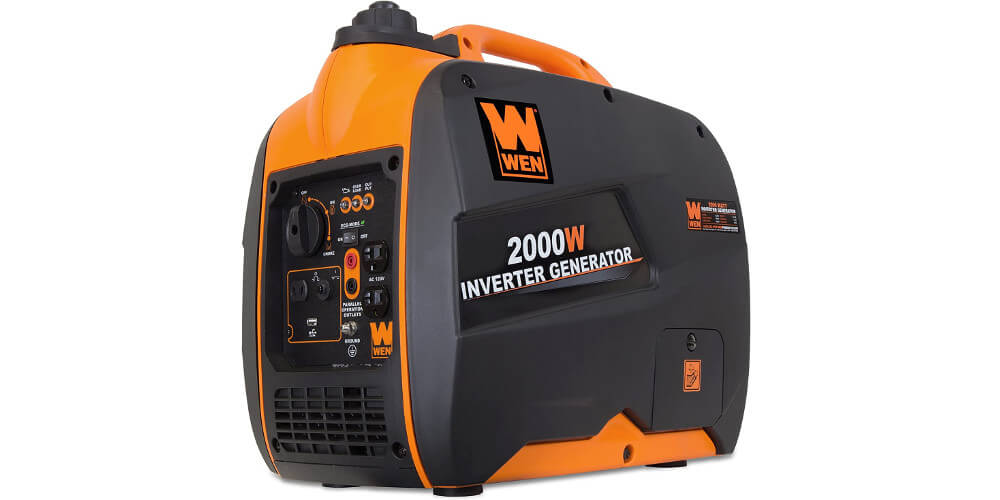
This compact and versatile generator doesn’t feature the direct RV port (having 30A or 50A capacity); meanwhile, it can power a lot of electronics inside and out the RV, and even charge smart electronic gear. Besides, it can double its output through the parallel connection to another WEN generator. Still, this unit doesn’t feature the variable voltage technology, limiting its area of usage to the 120V appliances.
The max output of the 56200i model makes 2,000W, and 1.600W makes the regular running feed. The generator can power up fans, stand-alone pumps, electric tools like drills, screwdrivers, etc. It can connect up to four different appliances through two AC sockets, one DC port, and the USB (5V) connection. All the connections feature overload protection. The produced electricity has very low harmonic distortion enabling safe charging of smart devices. The USB port can power up smartphones, tablets, boomboxes, laptops, alarm systems, and so on.
The tank onboard this generator is quite small having 1 gallon capacity. Still, it matches the engine having 77cc volume and performing in two modes: regular and eco-mode. The latter activates the hookup sensors that regulate the load on the engine and fuel consumption depending on the connected devices.
The engine doesn’t roar producing about 50 dBA within 20ft distance. At the max load, this quiet RV generator can be compared to the small washing machine noise level.
Pros
- Alert lights for low oil and excessive load.
- Can be used in the wild and parks thanks to the USDA-approved spark arrestor.
- Easy to carry along due to small weight (48 lbs when empty) and convenient top handle.
Cons
- No AC or DC breakers / main breaker.
- The side panel isn’t easy to remove and reinstall.
Champion 46596 3500-Watt
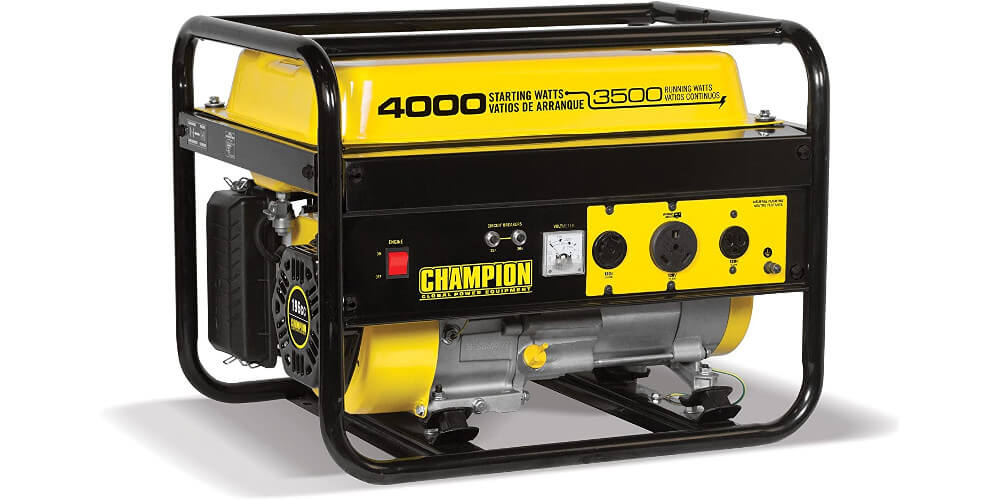
Simple, yet powerful, this RV generator provides everything that’s crucial for running RV electricity and camper tools. It also provides ample information on its state and operation, preventing malfunction due to untimely oil change or circuit overloading.
The engine installed in this unit has 196cc volume and is a 4-stroke type. It gets started quickly via the recoil starter, often with 1-2 pulls. The generator emits 3,500 running amps, with the rise up to 4,000 peak ones. It can handle various RV appliances at a time, while starting a 15,000 BTU air conditioner does make the machine work louder.
With a 3.8 gallon tank, the generator can work up to 12 hours at half of its maximum load (50%). The noise level produced could be compared to a loud conversation (about 68 dBA) while at a quarter load, it lowers to the “normal conversation” point.
Connections panel provides three types of outlets: the RV one (for 30 Amps feed), the locking 30-Amp port, and the 20A connection for the household network. All the outlets support 120V voltage. There are two circuit breakers shutting out the supply through the 30A or 20A outlet and preventing the overload to the circuit. The Volt Guard technology additionally secures the connected appliances from voltage spikes.
The generator is also equipped with the voltmeter to estimate the load at any time. Another safety feature is the low-oil sensor ceasing the engine run once the oil level is insufficient. The Champion 46596 could definitely be praised as the best portable generator for RV if only its basic equipment would include the transporting wheels.
Pros
- Cold weather start is performed quickly due to the optimized starting procedure.
- Intelligauge system provides immediate readings for voltage, HZ frequency, and runtime.
- Sturdy all-metal weatherproof build.
Cons
- No 240V option.
- The handle hangs in front of hot exhaust and can’t be used while running.
DuroMax XP12000EH
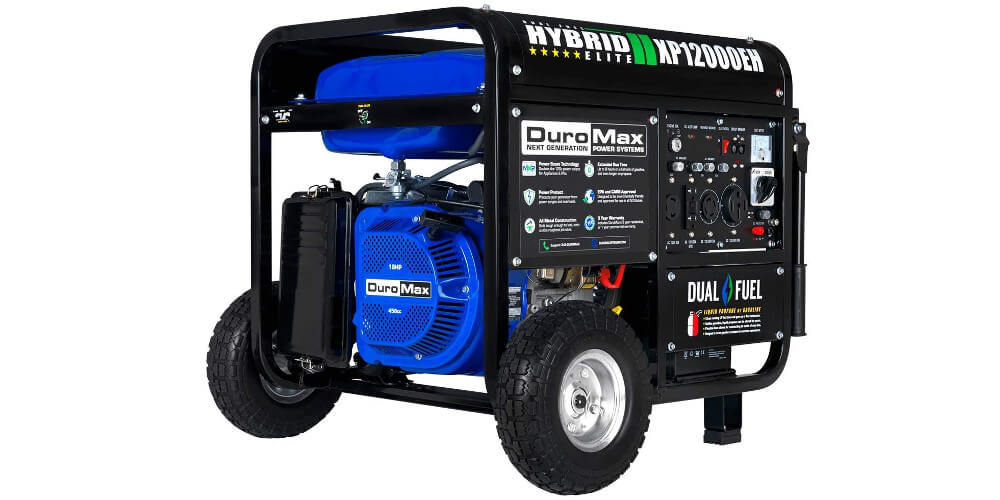
“Heavy-duty” is the right description for this powerful RV ready generator. Its high-quality build and lots of wattage make it a one-for-all unit: the RV camp, big-scale jobsite, or a modern house with lots of electric equipment can be powered with steady and safe current supply.
9,500W output at the running mode and 12,000W at starting one enable this generator to run the most demanding RV appliances like air conditioner and refrigerator while not shutting off the lights and the pumps, and even using microwave and inner outlets. The generator is equipped with a powerful (18HP) engine with a 457cc capacity. It features a low oil shut-off system and provides the smart handling of the load (less load — less RPM). This results in relatively low fuel consumption and extended runtime.
The XP12000EH implements a dual fuel system letting it work on gasoline or propane. The tank contains 8.3 gallons ensuring up to 8 hours of continuous work on gasoline and even more on propane.
This propane generator for RV offers numerous outputs with high-level protection and fits multiple applications. There are 5 outlets, with 4 individual breakers (a single one for two 120V/20A ports), the main circuit breaker, and DC protector control. The voltmeter and alert indicators let control the unit’s operation, and the idle mode is turned on and off by the dedicated switch.
Pros
- 120V / 240V knob lets select the voltage; the performance is boosted in the 120V option.
- Can power RVs of any type through standard 30-Amp and heavy-duty 50-Amp outlets.
- The electric starter is easy and quick to operate.
Cons
- Very heavy (224 lbs).
- Wheels are plastic and can get deformed under the generator weight.
Champion 42436 1200-Watt
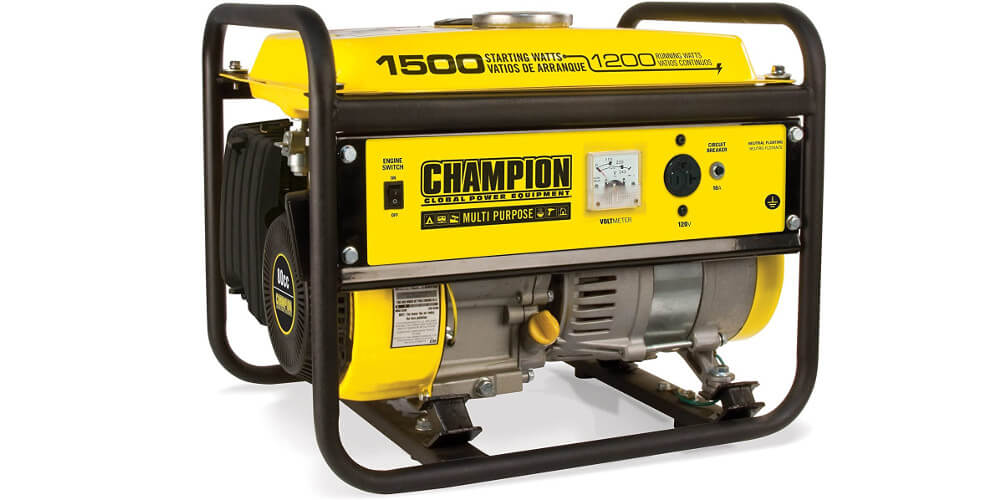
Relatively small wattage of this generator for RV is balanced by its steady work, solid construction, and low price tier. This unit makes a good backup as the auxiliary generator at the RV camping site. Meanwhile, it also can satisfy the needs of short RV trips not involving high-consuming appliances like an air conditioner or a microwave.
With 1,200 running watts, this generator can take the load of replenishing the RV battery (it’s recommended, though, to use the charger appliance between the generator and the power bank), or power up some of the camping equipment. With peak 1,500W, it can feed a small air compressor, a powered hammer, an outdoor light, etc.
The generator is started easily, with 1-2 pulls, and is overall simple to handle. It has a single 20A (120V) outlet for household appliances, secured with the standard 10A circuit breaker. The panel also has a voltmeter and the main engine switch.
The engine has 80cc capacity and is optimized for quick cranking in the cold. It’s air-cooled for safe operation and has a sensitive oil measuring system letting it shut off automatically at the low oil level.
Following the line of Champion generators, the 1200-Watt model has the cast iron frame and is built solidly. The metal is thick, and the parts are assembled precisely, without backlash or rattle. The unit is small (17.7 x 14 x 14.8 inches) and could be rated as the best generator for camping trailer among light-duty models. Still, having more connections and the wheels would be nice.
Pros
- Economic — a full 1.5-gallon tank suffices for 8-10-hours work.
- EPA- and CARB-compliant, can be used widely.
- Lightweight (52.9 lbs).
Cons
- No automatic voltage control.
- As noisy as big models (65 dBA at 23ft distance).
Generac GP3000i
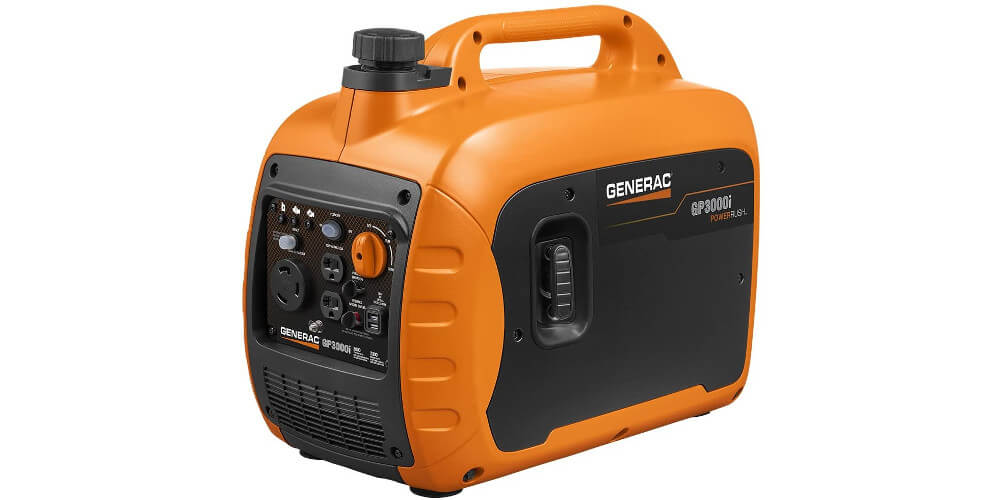
Having a versatile connections panel, good power specs, and featuring the Eco mode, this item could be easily introduced as the best generator for RV. However, no RV-dedicated outlet might become an issue for some plugs, while many RV-based appliances can be easily run from this generator output.
The 149cc engine with overhead valve boosts the generator to provide steady 3,000W of starting power and 2,300W for running operation. The starting power is extended due to PowerRUSH technology implemented, letting the generator maintain a stable high-wattage feed. This provides for a wide application area including small RV conditioners, fans, lights, and so on.
The outlets panel provides two 20A AC ports, 30A port, and two 2.1A USB ones. The latter provides 5V DC power, which is suitable for powering smartphones, laptops, headphones, flashlights, and other devices. The Truepower tech ensures there are no voltage spikes or surges through the outlets, protecting the connected electronics.
The inverter technology used enables low emission and efficient performance. On a tank of 1.06 gallons, the unit can run up to 5.8 hours, the Eco mode turned on. The latter is activated by the oval transparent button located near the turn-on switch.
The Generac RV generator is middle-sized (22.2 x 18.4 x 13.3 inches) but weighs less than many competitors (59.5 lbs). The controls panel is smartly laid out, with well-visible alert (low oil, overload) and normal operation lights. The parallel connection ports are covered with plastic caps to prevent occasional water and debris in.
Pros
- A single sturdy yet responsive switch for start/stop/choke.
- Maintains a parallel connection for doubling the output.
- Built-in wide top handle makes it easy-to-carry.
Cons
- Oil plug on top, the generator must be turned upside down to change the oil.
- The casing is mainly plastic.
Champion 75531i 3100-Watt
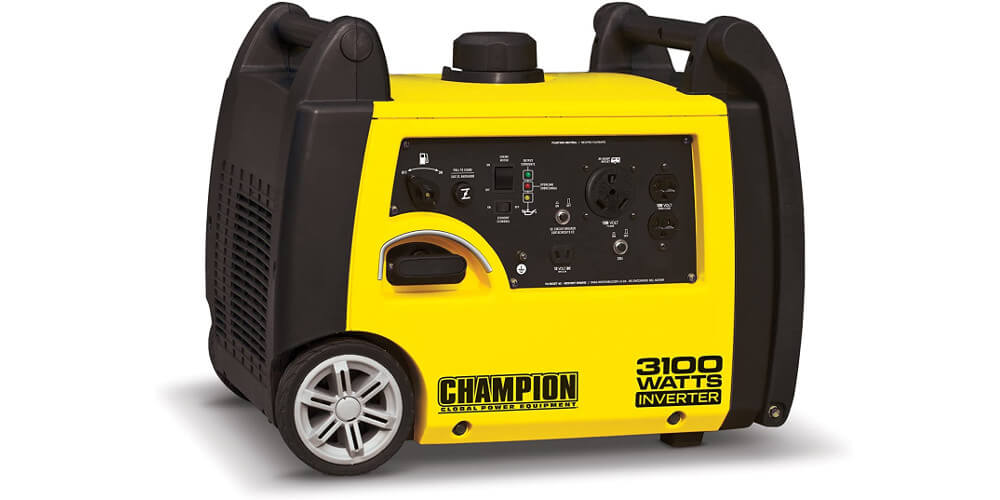
If you need a versatile RV inverter generator capable of running the RV internal system and powering other appliances through AC and DC outlets, add the 3100-Watt model by Champion to your comparison table. This generator provides a steady power supply, features basic security technologies, and has high portability.
In the running mode, the unit produces 2,800W, which rise to peak 3,100W. The 171cc engine has variable RPM, as the implemented Economy mode decreases them in the idle run. With the standard RV equipment turned on (lights, fans, AC or microwave, water pump, etc.), the generator works evenly and at the same noise level. The latter is quite low for a generator this powerful, making 58 dBA within the 23ft distance and slightly higher close to the machine.
The fuel tank on this model can take 1.6 gallons and gets exhausted in about 7-8 hours at the mild load. The fall of the oil level causes the generator to shut off, while the relevant light is blinking on the controls panel.
The generator can power the current through four connections. These include the RV-ready plug rated at 30A (120V), the 20A (120V) ports for various household appliances (like an iron, a coffee maker, etc.), and the DC (12V) outlet. The circuit breakers for both AC and DC let reset the connection and ensure no overcurrent drain. There’s also the red light on the panel signaling about overload issues while the system incorporates the automatic voltage control as well. This model could definitely take the place of the best generator for travel trailer, would it have a single start switch, as implemented in many competitor generators.
Pros
- Clean current signal with THD below 3% additionally secures the connected equipment.
- Highly portable: built-in rubber wheels, two top handles, and a big foldable U-shaped handle.
- Metal frame and high assembly quality.
Cons
- No voltmeter to trace the load.
- Small bottom clearance, hard to wheel on gravel and soil.
WEN 56475
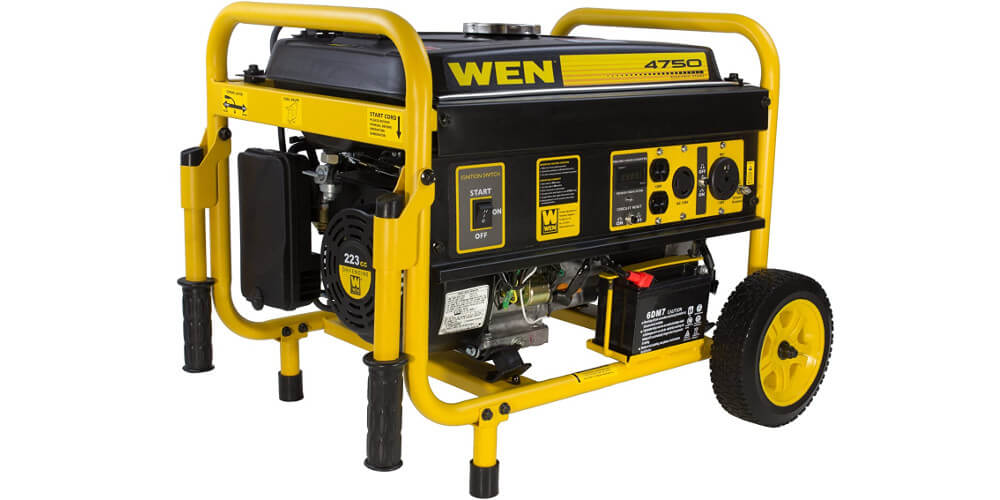
This powerful generator from WEN provides many connection options including the RV ready port, solid metal build, multiple safety mechanisms, and good portability. Add the electric start mechanism, and the top place in the best RV generator chart isn’t to doubt. Still, the choke control is performed manually making the starting procedure only half-automatic.
The power generator is equipped with the 223cc engine that runs steadily both at 3,750 (general running mode) and 4,750W (peak current mode). It can supply several RV appliances at a time, without the need to shut off the refrigerator in the electric operation or keeping the TV box unplugged. The air conditioner, lights, and the inside outlets can all be powered at once.
The fuel tank can hold up to 4 gallons of gas. The consumption isn’t on a high side; at 50% load, the generator can power up the electric equipment up to 11 hours.
The outlets board enables direct RV plug connection (30A output), the twist-lock port for 30 amps, and two 20A 120V connections. The AC breakers, AVR tech, and the low-oil shutdown mechanism protect the generator and connected appliances from overloading, excessive heating, and overvoltage.
This WEN RV generator is EPA- and CARB-compliant and is equipped with the spark arrestor. This means it can be used in a variety of locations including the woods and other wild nature places.
Pros
- Large rubber wheels and two foldable handles make it easy to transport even off-road.
- LED display shows the runtime and helps change the oil timely.
- The fuel gauge on top lets control the fuel level.
Cons
- Hooking up the battery is cumbersome due to tight space.
- No economy mode.
Honda EU2200i
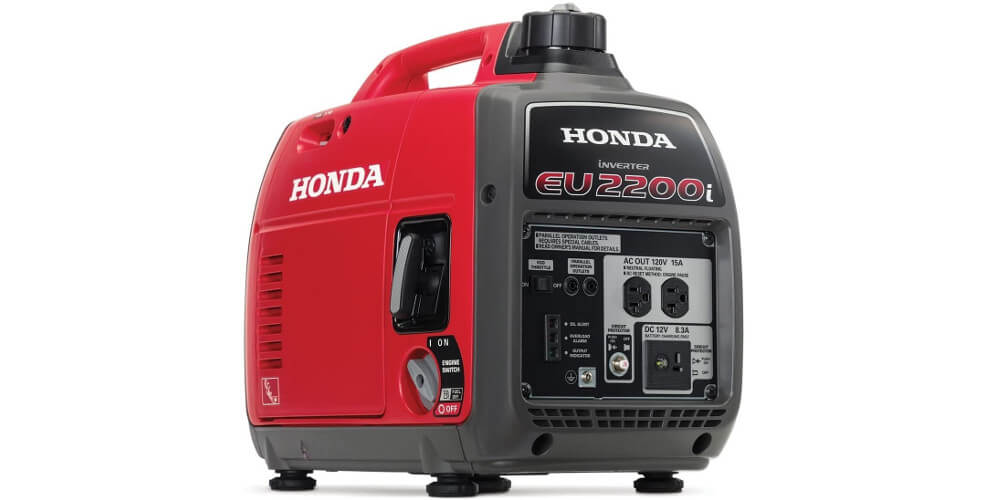
Being one of the smallest (16 x 20 x 11 inches) and lightweight (just 40 lbs) generators, the Honda EU2200i is popular among campers and is often mentioned on the lists of the must-have travel trailers generators. It’s an inverter type generator that provides a steady power output and features diverse functionality to power up the RV-based equipment.
The engine has 121cc displacement and supports the 1,800 running watts with ease. It’s simple to get started, with the responsive recoil and large engine switch just beneath. The peak current rates at 2,200W enabling the generator to feed various camping electronics including power tools, kitchen devices, and onboard batteries.
Should you need more watts and amps, the generator can be hooked up to another EU2200i model. This will double the output and ensure that even the most demanding equipment like 13,500 BTU air conditioner has the sufficient power supply.
The connections of this Honda RV generator include two AC and one DC port, all rated at 120V. AC outlets supply 15 amps and can be used for diverse purposes (powering the coffee maker, supplying the RV electric system, and so on). The DC connection provides 8.3 Amps and serves for replenishing the power banks (automotive and stand-alone models).
Safety mechanisms include the circuit breakers, the alarm panel (low-oil and overload indicators), and the efficient ventilation system (for better heat dissipation).
Pros
- Very quiet; at the quarter load, the noise makes about 48 dBA.
- In the Eco-Throttle mode, it doubles the fuel efficiency and can run up to 9.6 hours on a single tank.
- Sturdy rubber feet let place the machine on any ground.
Cons
- It doesn’t have a direct RV connection.
- Rather expensive in comparison to the competitor models with similar output.
Cummins Onan 5.5HGJAB-1270
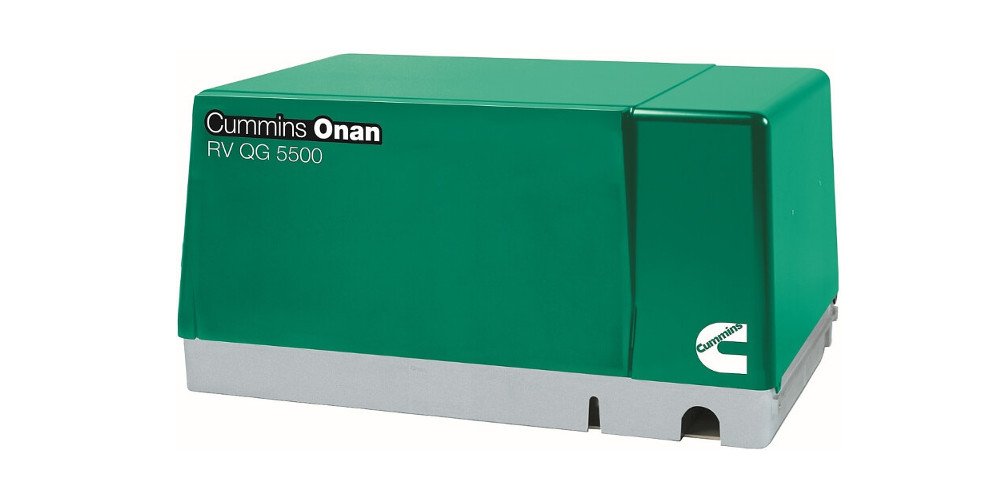
If you need a solid backup during your RV trips with the ability to have the batteries charged, the Onan RV generator should be on your shopping list. Its all-metal sturdy build and sophisticated inner construction let it power up any RV-based appliances and the most sensitive electric systems. The generator isn’t the portable type and is designed to be permanently installed in the RV.
The generator is run by a four-cycle 653cc V-twin engine, with a fully automatic start. It includes the automatic choke and remote start panel letting minimize the manual twiddling with the machine. At 2,400 RPM, the engine produces stable 5,500W power, which suffice to feed two high-capacity air conditioners and providing top 1,000W for all other equipment.
The inner security system features self-diagnostics and includes several technologies. The digital voltage control stabilizes the output with regard to the load of connected equipment. The electric fuel solenoid serves for optimal tank fill. The 30-Amp circuit breakers prevent the overcurrent. The engine speed is regulated automatically to prevent the under- and over speeding issues. The Stop switch shuts the generator completely in one touch. The fuel system is also equipped with the fuel and oil filters, while the low-oil and low-fuel mechanisms shut down the machine in case of relevant threats.
The generator is equipped with the spark arrestor and has the EPA, CARB, and USDA certification. It can use at the dense campsites and in the wild, as its maximum noise level makes 60 dBA at 50 ft distance (at 50% load).
Pros
- Runs on propane, which is more fuel-efficient and less messy during fueling.
- Operates in extreme heat, up to 120F.
- The replaceable air cleaner makes the generator wear- and time-proof.
Cons
- Large (33.6 x 22.2 x 16.7 inches) and heavy (288 lbs), not equipped with carrying appliances.
- No plugs, only AC leads for RV panel.
Buyer’s Guide
What Size Generator for RV Should I Pick?
Among both seasoned and beginner RV-ers, the question like “What size generator for 30-Amp RV?” has probably already hit the top questions list. In order to determine the generator size, consider the following factors:
- Wattage consumption. Draw a table, and include every appliance you’re planning to use during your RV trips. Make two columns, one for running power and another for starting wattage requirements. Remember to list the devices that would need a charge once and then, like a smartphone, flashlight, or wireless speaker. Then, think of the actual situation and what appliances you would use simultaneously. Draw another table, where list the situations and maximum starting and running consumption. This will let you understand your power needs and calculate the generator’s size (remember to add some 100-400 watts to avoid overloading issues). If your maximum wattage doesn’t exceed 600W — you’ll be good with the 800A and more generator. If it falls between 1,000W and 2,000W, consider more powerful models (e.g. for 1,900 running watts and 2,400 starting ones).
- Noise. The rule of thumb is “more power — more noise”, the dBs ranging from 50 on small generators (lower than 1,000W) to 78 on large models (3,500W and more).
- Size & weight. The more power the generator produces, the heavier and larger it is. The generators below 1,000W can be 16 x 13 x 14 inches, while the high-capacity 4,000W and more generators are closer to the 39 x 25 x 23 inches dimensions.
The 30 Amp RV will be fine with most of the 1,000W-3,000W generators. If you’re interested in what size generator for 50-Amp RV you‘ll need, it could be the same 3,000W. Still, to satisfy all your RV needs at once, you’ll need the large 5,000W+ models.
How to Start RV Generator
- Get through the manual. However boring it might seem, the manual will provide an understanding of the principle of work of the very model you have, and the way to start it. The safety rules and maintenance chapter should also be read before you set to start your generator.
- Get prepared. Disconnect all cables and check the level of oil and fuel. In the case of a new generator, the oil should be changed before the first start.
- Turn the fuel valve into the “On” position to let the fuel go to the carb.
- Close the choke. Turn the relevant dial or lever to the left.
- Activate the engine pressing the relevant switch.
- Pull at the recoil until you feel the vibration and release it gently. Repeat if necessary. If the engine is still, try to move the choke to the half-open position.
- Upon the engine working for a few minutes, set the choke to open / run position.
The modern generators become more automatic and some of RV power stations also provide that option. With a fully automatic start model, all you need to do upon the preparation stage is to press the “Start” button. With half-automatic machines, you might need to operate the choke manually and activate the engine through the electric start button.
How to Charge RV Battery with Generator
There are several ways to charge the battery of your RV with the onboard or stand-alone generator. However, in most cases, this will take more time than with the electricity network, due to the lower amperage of the generator. The usual generator load should also be considered. Before starting to charge the power pack, do the following:
- Disconnect all other connections if possible. If not, turn off as many hooked up appliances as possible.
- Fill the generator with fuel or hook it to the shore power source.
- Maintain the battery. Clean the leads and pour the distilled water if needed (applied to the non-sealed lead-acid power banks only).
Ways to feed your RV battery with the generator:
- From the DC outlet on the generator. If you have a battery charger, you can plug it into the port and trickle charge the RV battery.
- From RV outlets. While the generator powers up the RV network, it provides a steady current for the electricity system. Plug a battery charger into the outlet and connect it to the power bank.
- Through generator leads or plugged-in leads. You can try to power your RV battery via the direct generator leads or using the relevant leads appliance connected to the generator outlet.

My name is Brandon, and I’ve been interested in cars since I was a kid. I got a bachelor’s degree in Automotive Technology and worked in a private car workshop. I have two cars that have been completely upgraded with my own hands. So I successfully put all my knowledge into practice.
Last update on 2026-01-07 / Affiliate links / Images from Amazon Product Advertising API
